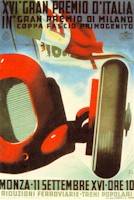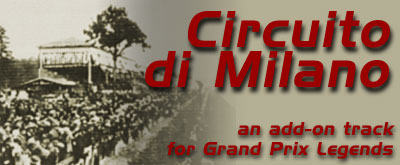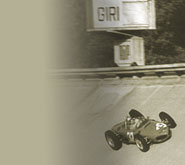|
Update - 6/15/01
The Milano full race length of 50 laps was selected
to provide a reasonable race duration for the "short" and "long" events.
The vast majority of all GPL races are run at one of these two lengths.
If a number lower than 50 is used, the "short" and "long" races are completed
too quickly.
If you want to run a full Grand Prix, you'll have
to edit your 67season.ini and gp.ini files to reduce the number of laps.
For reference, most of the real Monza events run over the full 10km were
between 50 and 80 laps in length. However, in 1961 (the last year that
the full 10km was used), the length was reduced to 43 laps. The GPL cars
can all complete a 43 lap event, so that's probably the number to use.
Original FAQ - 6/9/01
Think of the track as a single continuous 10km loop
that happens to overlay upon itself along the front straight. Thatís the
way the car sees it. The track location is measured in terms of distance
along this loop. This means that the two sections of the front straight
are actually 4.5 km apart. Graphically, the overlapping sections of the
front straight are made to look like each other. This provides the illusion
that you are in the same place, even though you are 4.5km away.
GPL does a pretty good job of keeping the overlapping
track sections separate, but not always. For example, during replays, if
you skip around, you will invariably create a situation where the graphical
display does not match the carís actual location. When you start the replay
from this situation, it will quickly correct itself.
No. The locations of the cars are also measured in
terms of distance along the centerline of the track. This means that a
car coming out of Curva Poca (a.k.a. Parabolica), and a car coming out
of the south banking are actually 4.5 km apart, so they cannot collide.
The cars also cannot see each other.
GPL apparently calculates sound proximity
in geometric coordinates (longitude and latitude). So for sound purposes,
you actually are close to those other cars. The same effect happens at the
bridge crossover. Some drivers have also reported seeing the cars on the
"other" part of the front straight during online races, but only in their
mirrors. To date, weíve been unable to isolate this effect to understand
when and how it occurs.
By the "right place", you must mean
along the front straight, and heading into Curva Grande. During the construction
phase, the start/finish line was originally on the front straight. However,
we encountered a situation where the overlapping track sections confused
GPL. When initializing cars on the grid to start a race, GPL would sometimes
put one or more cars on the "wrong" portion of the front straight (actually
4.5km away from where they should have been). Sadly, we never found a way
to solve this problem, so as a workaround, we moved the start/finish line
to its present location on the back straight of the high-speed oval.
An invisible wall isnít necessary. When you are on
one portion of the front straight, the "other" portion is a graphical
simulation. If you try to cross over and go down the "wrong" part of the
track, you will run into a dead end.
While on this subject, you might
try driving backwards down the "faux" Curva Poca. As you come out of the
south banking, slow down and make a hard right around the hay bales. If
you drive to the end, you get an interesting view of the south banking.
I do not recommend, however, that you try to drive backwards from Curva
Poca down the "faux" south banking. If you do that, youíll get a nasty
surprise. Youíve been warned.
Theoretically, this shouldnít be possible, because at
the crossover point, the oval and the road course are actually very far
apart (as measured in track space, distance along the centerline). However,
it did happen during testing. See Greg Campbellís replay in the "Extras"
section.
This was a design decision that was discussed extensively
with the test team. In the end, the greater number of drivers wanted to
have the option of running wide there Ė itís not necessarily faster, but
it provides some additional flexibility in trying to break the draft of
a pursuing car. Also, remember that thereís no risk of collision with cars
coming off of Curva Sud, so that was not a factor in the decision.
This was also a design decision. Once we decided to allow
drivers to run wide coming out of Curva Poca, the addition of the pylons
seemed out of place.
The bank angle is 38 degrees. This corresponds to the
angle at the top of the Monza banking as it was rebuilt in 1955. The real
banking at Monza is progressive Ė it is shallower at the bottom, and steeper
at the top. In Milano, it is a constant 38 degrees between the yellow lines,
and it gets a bit steeper above the top yellow line to provide a curbing
effect. The banking in 1922 actually was much shallower, although the specific
angle is unknown. We used the steeper 1955-style banking because we wanted
to capture the feel of racing through there side-by-side, as in the movie
Grand Prix.
Itís wide to facilitate on-line racing. The 1922 track
was very narrow, ranging from approximately 7.5 meters up to only about
12.5 meters in the high-speed banking. The first attempt at the banking
was 12.5 meters wide, but this felt awfully narrow when racing through there
at almost 200 mph. With the current width, side-by-side racing is easy,
and three abreast might be possible.
The track should actually be quite good for open races
online. From the start/finish, you run through the banking before heading
down to Curva Grande Ė this allows the field to stream out a bit prior to
Curva Grande, making a first lap incident there less likely.
This effect appears to be a result of GPLís prediction
algorithm being unable to cope with the geometry of the banking. Although
it looks a bit odd, itís harmless. You wonít see this in offline racing.
The setup compromise is not what you would expect. The
banking is so steep that the setup does not need to be tuned for grip, but
rather to keep the car from bottoming. So the trick is to get a setup that
is soft enough for the road course but hard enough to keep from bottoming.
The banking was reconstructed in 1955. The full 10km
course was used for Formula 1 (modern era) in 1955, 1956, 1960 and 1961.
An accurate 1961 Monza would be an incredibly difficult
project Ė not because of the banking and the crossover, but because of the
graphics. Papyís Monza is very graphically complex, and makes extensive
use of large and complex three-dimensional objects (3doís) to achieve realism.
An accurate and realistic banked Monza would have to be even more complex.
Given the current tools available, the 3doís required are way beyond the
capabilities of the average track builder.
We are more than willing to cooperate with individuals
who want to produce graphics updates for Milano. However, Milano is not
really suitable for modification into an historically-correct 1961 Monza
configuration Ė there is really very little in Milano that could be reused.
There are others who are very much interested in making the 1961 Monza a
reality, and a lot of work has been done by a number of different people.
You will probably hear more about this in the near future. |





